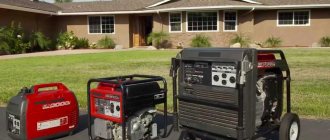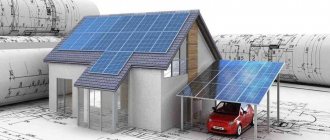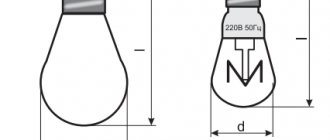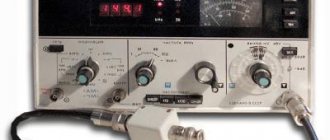Voltage transformation is present everywhere in every area of our lives and activities. The voltage generated at the power plant is increased to several kilovolts in order to be transmitted with minimal losses through power lines over many thousands of kilometers. And then it is again reduced at transformer substations to our usual values of 380/220 volts.
Step-up transformers are not used to stabilize voltage in cases where its value in the network is constantly changing. For home use, only stabilizers are used.
Let's look at the principle of operation of a voltage transformer in more detail, without plunging into unnecessary complications.
Voltage transformer
All windings are wound on a common core (magnetic core). If the number of turns of the secondary winding is greater than that of the primary, then it is a step-up transformer; if less, it is a step-down transformer.
The power of a voltage transformer depends on the cross-section of the winding wires, and the dimensions and weight depend on the type of core and wire material (copper or technical aluminum). In terms of design, it can be single- or three-phase. The most compact and lightest is the autotransformer, which has only one winding.
Clarification of a number of technical parameters
However, before starting the practical part, you will need to give clear answers to a number of questions.
- How exactly should the future unit change the current: increase it or decrease it?
- What voltage will be supplied to the primary coil and removed from the secondary?
- What will be the operating frequency of this device?
- How much power should it have after assembly is completed?
Step-up transformer
The first thought that comes to mind when the voltage in the network becomes low more and more often is to install a step-up transformer. At first glance, it seems that this is a simple and excellent solution, and now, finally, there will be normal voltage, bright lighting and stably operating electrical appliances. For a house or cottage with an allocated power of 5 kW, it will cost just over 19,840 rubles. — Progress AT5000R.
But not everything is so simple in the fairy-tale kingdom, and before you buy a step-up voltage transformer, the price of which is very attractive, think about one feature of its operation: it has a constant coefficient
voltage increase (transformation ratio). Let's look at this with an example.
Let's assume that your mains voltage is about 170 volts. To increase it to 220, you need a transformer with a transformation ratio of 1.29 (220/170). It seems that everything is working out well and logically, except for one thing: if the voltage in the network becomes normal 220 volts, then the output of the transformer will already have a very high voltage of 285 volts (220 * 1.29)! Not all electrical appliances can withstand such overvoltage for even a short time. So it’s not far from the fire!
As an option, you can purchase an adjustable autotransformer, the so-called. LATR, which provides a manual output voltage regulator. But it will not be a reliable solution, because... you will have to constantly monitor the value of the output voltage using the indicator and adjust it manually, especially during maximum load on the power grid from neighbors. If this is not done in time, then at the first surge in the power grid, the voltage at the output of the LATR will also rise sharply, and the connected electrical appliances may well burn out.
Therefore, step-up voltage transformers are applicable only when the network is ALWAYS significantly less than 220 volts, and this almost never happens
.
A guarantee of durability and reliability
In general, the winding and assembly process does not cause much difficulty. This method can produce devices for a range of applications, including halogen lamps.
In order for the result of all the efforts made to be a unit that is actually suitable for use, the winding technique described above must be carefully followed. This will guarantee not only the serviceability of the transformer, but also its uninterrupted operation for a very long time.
Classification and types
Transformers are divided into several types depending on their application and technical characteristics. The main classification parameters are:
- Number of windings.
- Number of phases.
- Cooling method.
- Accuracy class or possible errors.
- Type of allocation.
Transformers designed to regulate electric current are called current transformers. If the device regulates voltage, then it is called a voltage transformer.
The voltage varies depending on the number of transformer windings:
- The primary takes the voltage.
- The secondary transmits the changed voltage.
A transformer for a home is called a step-up transformer if it has more turns in the secondary winding than in the primary, otherwise it is a step-down transformer.
The cross-section of the winding wires affects the power of the transformer, the materials used to make the wires and the type of core affect the size and weight of the device. All devices according to the type of execution are divided into three-phase and single-phase.
The simplest transformer with minimal weight and compact dimensions is considered to be an autotransformer with one winding. Such models are budget options and are most often used in automatic devices and high-voltage electrical networks. Autotransformers do not have galvanic isolation, which is their disadvantage.
Power transformers are used to supply and receive electricity to and from power lines. Electrical appliances are equipped with network devices.
Purchase of components and consumables
After the schematic diagram has been fully prepared, you can begin purchasing the parts and consumables needed for assembly.
Usually, the necessary materials and accessories, including varnished wire and terminals, are easy to find in the first radio store you come across.
First you need to buy
- Electrical tape or heat-resistant tape;
- Core configuration corresponding to the project;
- Insulated wires.
Tips for choosing
Before purchasing a voltage stabilizer, you need to decide whether it is needed or not, but for preventive purposes it is still worth installing, since the voltage in electrical networks often varies.
When choosing a mini-transformer, the following characteristics are taken into account:
- Number of phases.
- Output power.
- Weight of the device.
- Transformer dimensions.
- Operational life.
- Operating voltage range.
- Speed of reaction to power surges.
The load of specific devices must be clarified. Single-phase transformers are purchased for low-power household appliances, three-phase stabilizers are purchased for a large number of devices that require load distribution.
One of the most popular and sought-after transformers is the Resanta ASN, a single-phase digital stabilizer with an affordable price of 2,600 rubles. This transformer is mounted on the wall.
A more expensive and reliable model is the Shtil stabilizer. Its approximate cost is 4,000 rubles. The Shtil stabilizer is optimally suited for protecting electronic equipment and household appliances at alternating voltage.
Frame production stage
The frame part is made of cardboard. Those who do not yet have experience in such assembly and therefore do not know how to make a transformer frame with their own hands must take into account that its internal part must have larger dimensions than the core.
If a ring-shaped core is used, there will be two coils. When choosing an W-shaped core configuration, there will be only one coil.
Voltage transformers
Voltage transformers are static electromagnetic devices that change alternating voltage. Such stabilizers are divided into several categories depending on their purpose:
- Power. They are used to increase and decrease voltage, which allows current to be transmitted over long distances and to consumer devices.
- Technological. High-power devices used for technological purposes - furnace, welding and others.
- Low-power. Installed on television and radio equipment, household appliances and various electronic circuits.
- Measuring. Used to expand the measurement boundaries of devices.
Voltage transformers can be used for both monitoring and measuring voltage and power. They can power alarm systems, electrical automation circuits and effectively protect power lines.
The benefits of a detailed drawing
After providing comprehensive answers to the above questions, a diagram of the transformer device can be drawn up on paper or on a computer. It is not superfluous to do this even with a clear understanding of all the parameters and features of the radio component.
Often a drawing allows you to significantly clarify
- Scheme of connecting and bringing out contact wires;
- Number of plates in the W-shaped core;
- Method of arrangement of primary and secondary coils.
Step-up transformers
These are power devices installed in electrical circuits for household or industrial purposes and increasing voltage. Depending on the area of use and characteristics, transformers for the home are divided into several types that supply voltage:
- Autotransformer. Single-phase single-winding device.
- Current transformer. A stabilizer consisting of a core, several windings, optical sensors and resistors.
- Power devices. Current transfer between circuits is carried out using electromagnetic induction.
- Anti-resonance stabilizers. Closed single-phase or three-phase devices.
- Grounded transformers. Equipped with a special type of winding.
- Peak transformers. Separate alternating and direct currents.
- Transformers for the home. Designed to transfer electricity from a source to a consumer device and eliminate interference in the operation of household devices.
How is it arranged?
The device includes a ferromagnetic core and two windings. The division is determined by the operating principle. The primary, in contact with the electrical network, creates a magnetic field that crosses the turns of the secondary winding. There should be no contact between them. More turns in the primary winding creates a lower voltage. As a result, an electromotive force arises, generating a voltage that differs significantly from the input.
Its performance is affected by the number of turns. Operation is accompanied by inevitable losses amounting to 3% of power.
The vast majority of electrical household appliances require an alternating current network to operate. As a rule, step-down transformers are placed in a special housing. But this is largely determined by its purpose and model and, of course, by the manufacturer itself. This is due to the fact that they are components of most power supplies, stabilizers and other similar devices. Models with several terminals on the secondary winding are common. They won public recognition due to their versatility and multifunctionality.
Home Step Up Transformers
They are installed in situations where the voltage of the electrical network is less than the required 220 V. Such models have a constant transformation ratio: with a stable voltage of the electrical network, the final figure will be significantly higher than that required to power electrical appliances, which can cause their breakdown. Output voltage control is provided on some models in manual mode. Industrial transformers cannot be installed at home, as their operation can be dangerous due to the use of specialized cooling oils.
Step-down transformers
To connect devices for which the voltage of 220 V is too high, step-down transformers of 15 or 10 volts are installed. The advantages of such transformers for the home are the following characteristics:
- Protection against fire and electric shock, which is important when using such devices in rooms with high levels of humidity - bathrooms, bathhouses and others.
- Minimum electricity consumption - low-voltage lighting devices consume several times less energy, unlike standard ones.
- Increasing the service life of devices.
Chargers for various gadgets and household devices are equipped with integrated transformers, and therefore they do not require the installation of such stabilizers. Self-installation of transformers for the home is necessary when installing low-voltage lighting based on halogen and LED lamps.
Why is the popularity of electronic transformers increasing?
Technological advances have contributed to the introduction of electronic step-down transformers into the market. Compared to classic ones, they have a number of advantages. This contributed to their consolidation in the market and their gradual introduction into the everyday life of the average user.
One of the main features is the design. The usual coils and cores have been replaced by precision microcircuits, capacitors, resistors and other precision components. Using this type of device has its negative and positive sides.
Advantages:
- Compact sizes. In relation to classic transformers, they have become more compact and do not take up much free space. The new product is compact, lightweight, easy to install and subsequently use.
- High efficiency.
- An input load is required to start. Normal connection to the network does not activate the transformer. This saves energy.
- Silent operation;
- High-intensity operation does not overheat the voltage converter. Under any load, the housing temperature is maintained at a safe temperature for humans and others.
- Availability of built-in protection against short circuits and dangerous overloads.
- The device is equipped with a circuit that ensures the safe use of electrical networks;
- Affordable price.
Flaws:
- budget models do not have protection;
- many models are delivered to shelves without a built-in filter;
- fails quickly;
- low power.
Summary
Purchasing a transformer for home use in most cases is a necessary decision and is not difficult if you carefully study the classification of devices and their purpose. Correct selection of stabilizers provides the power necessary for the operation of household appliances without the risk of equipment breakdown and failure. Installation of transformers can be done either independently or after contacting specialists.
Unstable voltage in the electrical network is a frequent problem and entails unpleasant consequences from breakdowns of electrical appliances to damage to electrical wiring and fires. A wide variety of problems can be partially solved by installing a home transformer - a statistical electrical device used to convert electric current or voltage.
The best transformers with 220-110 V change
Robiton 3P100
Power supply for electrical appliances with a voltage of no more than 110 V. The maximum output power is 100 W. It is equipped with protection against overheating, short circuit and overload.
transformer Robiton 3P100
Advantages:
- compact dimensions;
- passed certification according to European quality standards;
- The kit includes a European-style power plug.
Flaws:
- from the 50 Hz output, some hair clippers may not operate correctly;
- powers only one device in use.
Problems in electrical networks
Electricity is initially supplied through power lines from the supplier's step-up transformers and can travel up to several hundred kilometers to an individual home. When installing a step-down unit on several consumer houses, the loads will be divided between all connected houses.
It is much more profitable, although more expensive, to install an individual transformer for the home - in this way the internal electrical network will receive a current reduced to 220V.
In cases where there is a regular voltage drop in the electrical network, in which the devices are not able to function at full capacity, the problem can be solved by installing a step-up transformer.
Reel Rods and Handle
Next, miniature holes with a diameter of 8 mm are drilled. Rods are inserted into them onto which the transformer coil will be strung.
- All that remains is to apply a small diameter thread, tighten the washer and mount the handle.
- It is important to note that the dimensions of such a machine can be anything.
- In other words, it can be fully adapted to the intended core size.
- However, if the project involves the use of a ring core, then it will have to be wound entirely by hand.
Types and classification
Depending on the technical properties and scope of application, transformers are classified quite differently. The main parameters for classifying transformers are:
- number of phases;
- number of windings;
- accuracy class – fluctuations in the maximum possible error values;
- cooling method;
- type of placement.
If the operation of the transformer is aimed at regulating the electric current, then the device is called a current transformer. In the case where the device is designed to regulate voltage, it will be a voltage transformer.
The direction of voltage changes is influenced by such an indicator as the ratio of the number of windings of the device:
- primary, receiving voltage;
- secondary, transmitting the changed value of the electric current voltage.
In the case when the transformer has a greater number of turns in the secondary winding than in the primary, it is classified as step-up, and with a smaller number, it is classified as step-down.
The power of the transformer is affected by the cross-section of the winding wires, and the weight and size are affected by the type of core and wire materials. Based on their design, transformers are divided into single-phase and three-phase.
The lightest and smallest autotransformer is considered to be one with only one winding. Also, autotransformers are the most budget option and are often used in automatic control devices, and are also used in high-voltage electrical networks. The only drawback of such a transformer is the lack of galvanic isolation.
Assembling the winding machine
When making this electrical device yourself, you will need to wind the wire. Winding a transformer with your own hands is carried out on a simple homemade machine tool. You can do it in a couple of hours.
First you need to take a board measuring 10x40 cm. A couple of bars measuring 50x50 mm should be attached to this base with screws. The distance between them should be at least thirty centimeters.
Voltage transformers
A voltage transformer is a static (stationary) electromagnetic device that changes the values of alternating voltage. According to their purpose, such devices are divided into several types:
- power - used in power supply both to increase (to transmit it over long distances) and to decrease (to the operating values of consumer devices) voltage;
- technological – devices with increased power, used for technological purposes (welding, furnace and others);
- low-power – they power television and radio equipment, household appliances, and are also used in various electronics circuits;
- measuring - used to expand the boundaries of measuring instruments.
Voltage transformers are used both to measure it and to control power parameters. They effectively power automatic electrical circuits, alarm devices, and are also used to protect power lines.
Step-up transformers
They are power structures used in electrical circuits for household or industrial purposes, changing the voltage in an increasing direction.
According to their characteristics and areas of use, the following types of voltage boosting devices are distinguished:
- autotransformer - a single-phase device with one winding;
- current transformer - a device using several windings, a core, equipped with resistors and optical sensors;
- power type device - designed to transmit current between circuits by means of electromagnetic induction;
- anti-resonance unit - a completely closed single-phase or three-phase device;
- grounded devices - have special types of winding;
- peak transformers - used to separate direct and alternating currents;
- home household units - transmit electricity from the current source to the device to the consumer, prevent interference in the operation of devices.
Transformers that convert voltage from 220V to 380V are widely used in three-phase networks of industrial areas. With their help, problems of creating additional electrical power lines are easily solved. In addition, these units help to symmetrically distribute loads across network phases in places where there is no 380V network.
Winding wire and applying insulation
If a round core was chosen as the base, then it should first be wrapped with electrical tape. Next you can start winding the wire.
- After the application of the primary winding is completed, it is covered with dense insulation.
- Then it’s time to wrap the second layer.
- The ends of the windings are brought out, and contacts are soldered to them for interfacing with other equipment.
Step-up transformer for home
The need to buy a step-up transformer for your home arises when the voltage in the electrical network does not reach the required 220 V. However, it should be remembered that the device has a constant transformation ratio. This means that when a stable electricity voltage is reached in the network, the output value will significantly exceed that required to power electrical appliances, which can lead to their breakdown.
There is the option of purchasing an adjustable device, which provides manual control of the output voltage.
It is worth knowing that installing industrial transformers at home can be extremely dangerous due to the use of specialized oils for cooling them.
Step-down transformers
For certain devices used in everyday life, a voltage of 220V is unnecessary - it is recommended to use step-down transformers to connect them (220 to 15 volts or 220 to 10 volts).
The advantages of using these mini-transformers for the home include:
- protection against electric shock and fire (especially important in bathhouses, bathrooms and other rooms with high humidity);
- saving energy consumption (low-voltage lighting devices consume several times less energy than conventional ones);
- extending the service life of devices.
Chargers for phones, laptops and other gadgets already have built-in transformers, but when installing low-voltage lighting using LED and halogen lamps, you need to independently install devices to reduce the voltage.
So, buying a transformer for a private home or cottage will not be difficult if you carefully study the types and purposes of various types of devices. The right choice will help ensure the availability of the power required to operate the devices without the risk of equipment failure.
Personal assembly
Many radio amateurs and simply curious people periodically ask how exactly to assemble this or that transformer on their own.
Despite the simplicity of solving this problem, you still need to have some skills in working with radio components and understand the physical principles of operation of this device.
Naturally, you will first have to carefully study the entire technology:
- Core preparation;
- Winding coils;
- Applying layers of insulation.











